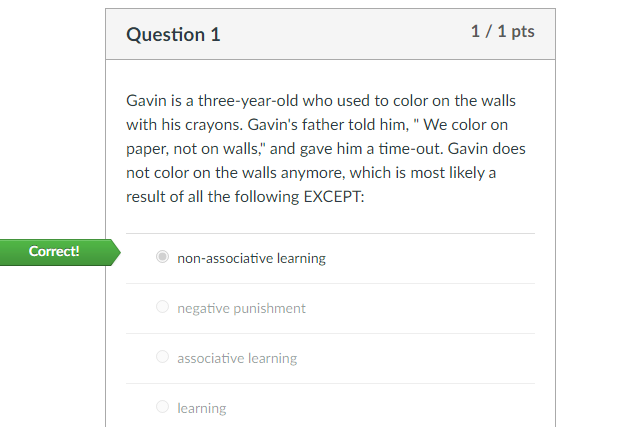Chapter 6 Homework: Learning-PSYC-101
Chapter 6 Homework: Learning
Question 1
Gavin is a three-year-old who used to color on the walls with his crayons. Gavin’s father told him, ” We color on paper, not on walls,” and gave him a time-out. Gavin does not color on the walls anymore, which is most likely a result of all the following EXCEPT:
When Juan moved to a new house near an airport, he looked up in the sky every time he heard an airplane engine overhead. Now, after a few months of living there, Juan barely notices the sound of the airplane engines anymore. What is the best explanation for the change in Juan’s response?
habituation
latent learning
vicarious conditioning
negative reinforcement
When you encounter a growling dog on the sidewalk, your heart begins racing and you feel afraid. Because this is an unlearned response, in terms of classical conditioning, is would be called a(n):
conditioned response
unconditioned stimulus
unconditioned stimulus
conditioned stimulus
unconditioned response
If Carlos wants to use classical conditioning so his three-year-old sister learns to be afraid of dogs, he should:
blow an air horn to make her afraid every time she pets their own dog
give her a piece of candy every time she is afraid to go near the dog
Emmanuel’s grandmother often baked treats for him, and he learned to come running whenever he heard her kitchen timer ding. One day he came running into the kitchen when the microwave timer beeped and expected a freshly baked treat from his grandmother. Emmanuel’s response is due to:
stimulus generalization
stimulus discrimination
spontaneous recovery
habituation
You want to teach your dog to stop scratching at the door when he wants to go out. You do so by spraying a little water from a water bottle in his face every time he scratches at the door. By creating consequences for your dog’s behavior, you have used to train him.
classical conditioning
operant conditioning
operant conditioning
shaping
modeling
Percy wants to teach his daughter good manners. To increase the likelihood of her saying “Excuse me” when bumping into someone in the store, he should use a stimulus called a(n):
token economy
reinforcer
punishment
operant
Question 8
A scientist who wants to train a behavior quickly should use a schedule of reinforcement, but a scientist who wants a behavior to persist for as long as possible should use a schedule of reinforcement.
continuous; partial
partial; partial
partial; continuous
continuous; continuous
Question 9
Professor Jackson periodically gives his students pop quizzes after they complete weekly reading assignments. To maximize the likelihood that his students will complete the reading assignments, the schedule of reinforcement he should use for the pop quizzes is a schedule.
variable ratio
fixed ratio
variable interval
fixed interval
Samantha tells her roommate that negative reinforcement and negative punishment are similar because they both:
increase behavior
add a stimulus
add a stimulus
decrease behavior
Melanie is getting D grades in several of her classes. The most effective strategy to get Melanie to study more would be for her parents to:
ignore Melanie until she gets higher grades
punish her for poor academic performance
praise Melanie when she practices good study habits
Question 12
While punishment is effective in shaping behavior, several drawbacks have been identified through research. Which of the following is NOT a drawback of punishment?
punishment teaches people to avoid getting caught rather than how to behave appropriately
Punishment can lead to negative relationships between parents and children
Punishment can teach children that aggressive behavior is ok
Punishment requires more effort than reinforcement
A device in Jaclyn’s care beeps loudly whenever she brakes too quickly. After three months of using the device, Jaclyn’s insurance company will lower her rate if her driving improves. The device is being used as what type of operant-conditioning technique?
Correct!
behavior modification
shaping
insight learning
continuous reinforcement
The primary method of learning prosocial behaviors in young children is through:
observational learning
positive punishment
shaping
Billy has watched many movies in which the hero smokes cigarettes. Billy identifies with these heroes and begins to smoke himself. Billy’s new smoking behavior is best explained by:
latent learning
partial reinforcement
partial reinforcement
positive reinforcement
Question 16
Elianna watches a YouTube video of a skateboarder failing to complete a risky jump and landing in a painful position. She winces and says, “Ouch, that hurts,” when she watches. Elianna can feel the skateboarder’s pain because:
her mirror neurons are active
her brother is a skateboarder
she hears the skateboarder cry after he falls
she remembers falling
While visiting Disney World over spring break, Sara had to stand in line to ride the Colossal Roller Coaster. It was 94 degrees that day and after standing in line for 1 hour, Sara started to feel dizzy from the heat. The Colossal is right next to the Small World ride, so while she waited in line she listened to the song “It’s a small world” over and over. The following day, it was also hot and while standing in line for the Zip line ride for over an hour, Sara started feeling dizzy from the heat. The Zip ride was also near enough to the Small World ride that she heard “It’s a small world” over and over again while she waited. On the third day, the weather was cloudy and cool but as Sara passed the Small World ride on her way to another roller coaster she heard “It’s a small world”, and started feeling dizzy even though it was a cool day.
Use complete sentences when answering the questions
What is the unconditioned stimulus in the example above? (1 pt)
What is the unconditioned response in the example above? BE SPECIFIC (1 pt)
What is the conditioned stimulus in the example above? ( 1 pt)
What is the conditioned response in the example above ? BE SPECIFIC (1 pt)
Answer preview-Chapter 6 Homework: Learning-PSYC-101

$8.00
